Now that you know who the players are, here is their (abreviated) story.
Georgetown
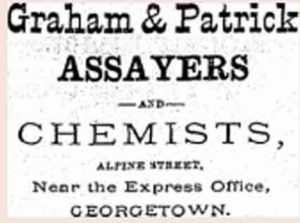
In 1876, Will was working as an assayer in Georgetown. He worked for one of the reduction mills, but I haven’t found a name. Then he was in partnership with a fellow St. Louisian, Frank Graham, who was a chemist.
But in 1878, on Feb. 14 the Georgetown Courier, had a small announcement: “Wm. F. Patrick, who has been for nearly two years in town, emigrated to Leadville last week to join Tom Campbell in an assay office.”
Leadville
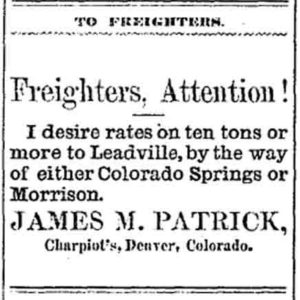 In March, this ad appeared in Denver and Colorado Springs newspapers. James is in Colorado and in partnership with Will and Thomas Starr, a well-known miner from the Oro City days of California Gulch. They incorporated the Lake County Sampling Works in May.
In March, this ad appeared in Denver and Colorado Springs newspapers. James is in Colorado and in partnership with Will and Thomas Starr, a well-known miner from the Oro City days of California Gulch. They incorporated the Lake County Sampling Works in May.
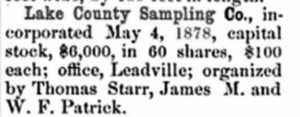
But this first project of the brothers’ doesn’t go well. In June, the Leadville papers announce that the Patrick and Campbell Lake County Sampling Works had started up. James and Starr seem to be out of the picture.
On July 22 a Leadville paper reported: Our city was treated to genuine excitement this afternoon. A million fizzing fire-crackers or a half a dozen first-class comets would not have made the racket produced by the steam from a collapsed flue at the Sampling works of Patrick and Campbell, in the upper edge of the city. The entire population rushed to the scene of the accident expecting to gaze upon the scalded and mutilated bodies of operatives. Fortunately, no one was at all injured.
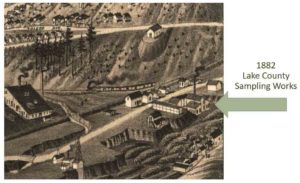 The 1879 & 1880 city directories lists the Lake County Sampling Works as owned by Gillespie, Ballou and Company, with Will as bookkeeper and assayer in 79, and Mr. Campbell seems to have left town.
The 1879 & 1880 city directories lists the Lake County Sampling Works as owned by Gillespie, Ballou and Company, with Will as bookkeeper and assayer in 79, and Mr. Campbell seems to have left town.
In March 1881, the Leadville Daily Herald had a brief editorial that since the Sampling Works had been taken over by George P. Lockwood it had been running at capacity. It is not listed in 1882. And by the time Sanborn made the map of Leadville for 1883, the sampling works are listed as not running and machinery in bad order.
So the first business venture doesn’t seem to have done well.

These are Will’s mining interests that I have been able to find. It probably isn’t all of them. These include mines in which he took an active part in managing to mines where he just owned stock or grubstaked some prospectors and it didn’t pan out. You’ll notice that several stop at the end of 1887. That is because that is where Will’s cashbook ended. I am sure that several of the mines continued on. 1885 and 86 look especially busy for Will. The mines in red, the Aftermath and Col. Sellers are the important mines to Will.
The Gold King is in red just because the conference is in Telluride and the Gold King is nearby. Will owned stock and evidently also had a lease on the mine. The only thing I know for sure about his involvement with the Gold King is that it resulted in Will and L.L. Nunn exchanging lawsuits for several years.
The Aftermath was Will’s first big mine. He had grubstaked two prospectors around 1878, who discovered what would become the Aftermath Mine on Elk Mountain in the Ten Mile district. Will and four partners bought out the prospectors and Will took charge of the mine which became one of the biggest producers in the district. The partners sold the mine in 1880 for $250,000. Will supervised the mine until the summer of 1881 when the deal was finalized. His take was $52,000.
The names in blue are mining ventures that included family. Around 79, James and three other men located the St. Louis Lode on Breece Hill and by 1881, Will had a 1/8th interest also in the St. Louis. This went better. Will made money from the St. Louis and sold his interest in 1889. I don’t the history of James’ ¼ interest.
We will get to the Monitor Zinc Company and the Bay State Mine in Aspen soon.
The 1880 census shows that Warner had moved to Colorado and was sharing a house with Will and two other friends from St. Louis. Both Will and Warner are shown as “assayer.” The 1880 city directory shows Will as working as the assayer at the Cummings and Finn’s Smelter and is the last time that Will is identified as an assayer. He is not in the 1881 directory, probably because he was living in Kokomo, supervising the Aftermath until the sale was final. And in 1882 he was back in the Leadville directory, this time identified as “mining,” His brothers are never listed in the Leadville city directories even though newspaper articles show that they were in Leadville from time to time.
The longest line, the Col. Sellers, was Will’s greatest success. In 1882, Will was involved somehow with a shady St. Louis lawyer, Frank Bowman. In January, Bowman was in Leadville and he met a mine promoter who told him about some claims on Iron Hill, just east of the AY and Minnie mines.
Not knowing a thing about mining, Bowman looked the claims over and thought they were a good investment. Will and Bowman agreed to develop the claims for a full one-half interest. Bowman returned to St. Louis promising to send his share of the costs of the development, but never did. In March, James bought one half of Bowman’s share by paying what Bowman owed up to that point. In July, Will offered to buy the rest of Bowman’s share and so Will ended up owning 17/48th of the Col. Sellers, while James owned 4/48th. In 1895, their mother, Eliza, bought some or all of Will’s interest in the Col. Sellers. The newspaper notice isn’t specific.
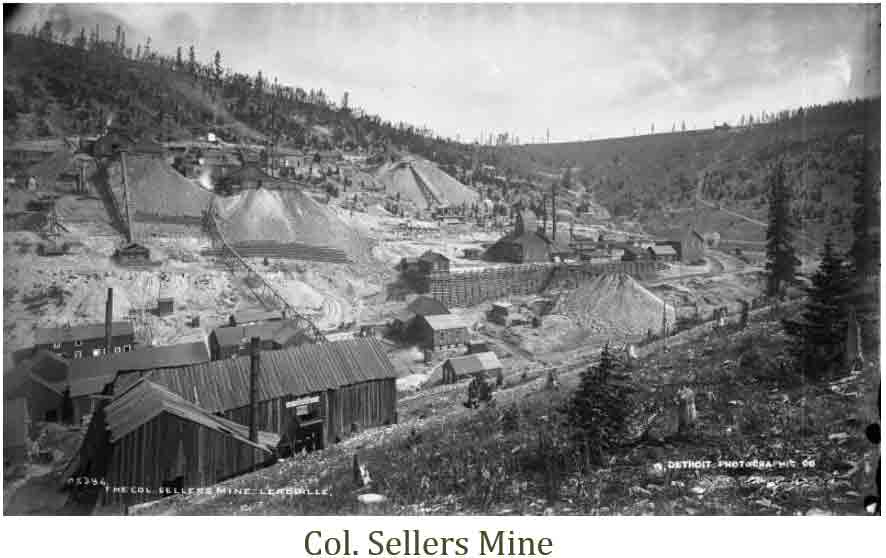
The Col. Sellers, Accident, Good Hope, and Helen Mines were collectively known as the Col. Sellers. The Col. Sellers was a good, steady silver producer over the next 10 years, eventually paying out about a million dollars in dividends. It received a lot of coverage in the Leadville and Denver papers and Will was well known as its owner/manager. It had a concentrating mill, designed and built by David Brunton. Brunton stayed on as supervisor of the entire mining operation for several months until he discovered how much he liked being an expert witness in mining court cases and then he resigned.
James, Warner, and Lucien were never listed in the Leadville city directories, but from newspaper accounts and personal papers, I have glimpses of them in Leadville and working at the Col. Sellers.That was their school of mining, even though Lucien was to claim a mining engineering degree From Washington Univ. later in his career.
Denver
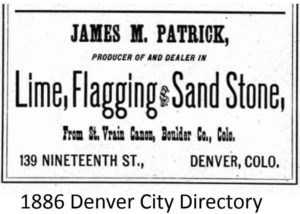 Instead of going off on his own in mineral mining, James decided on living in Denver and dealing in red sandstone from Lyons, Colorado. From the 1880s to just after the turn of the century, sandstone was used for roadways and sidewalks not only in Colorado, but all over the mid-west. If any of you have had a chance to visit the University of Colorado campus in Boulder, you will see the red sandstone used for the campus buildings. The sandstone paving industry was a very competitive business. By 1892, there were over 40 sandstone companies listed in the Denver directory.
Instead of going off on his own in mineral mining, James decided on living in Denver and dealing in red sandstone from Lyons, Colorado. From the 1880s to just after the turn of the century, sandstone was used for roadways and sidewalks not only in Colorado, but all over the mid-west. If any of you have had a chance to visit the University of Colorado campus in Boulder, you will see the red sandstone used for the campus buildings. The sandstone paving industry was a very competitive business. By 1892, there were over 40 sandstone companies listed in the Denver directory.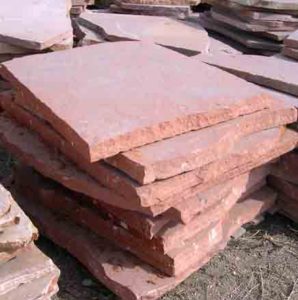
This ad mentions that the stone is from St. Vrain canyon, which is to the southwest of Lyons. In 1891, Eliza, Will, and William Eddy joined with James to form the Patrick Red Sandstone Company. The company’s quarry at that time was located on Beech Hill which was a couple miles north-west of Lyons.
The company was never financially viable. Since they were so far from Lyons, the workers had trouble getting to and from quarry on a daily basis. So the company had to provide food and shelter. A cook house was built first and the quarry workers slept in tents. Ok in the summer but in the winter, not even Russian workers stayed long. Eventually, a bunkhouse and office were built but the company records shows many work stoppages until the workers were paid. The onsite manager wrote daily reports to the Denver office and they are filled with complaints from workers about not being paid, or how nice it would be to have an actual office, or information that the railroad needed to be paid by a certain date or they would refuse to carry the company’s goods. The company was officially dissolved in Feb. 1892, just over a year after its creation. But James kept up some sort of business until 1897 or so.
I think the family tried to help James, but just couldn’t continue to throw their money away on a company that wasn’t going to make it.
Rico

Warner chose to make his mark in Rico, Colorado. His first known venture was the Reily Lode in 1882 with three other miners. He had a few other mines over the years around Rico.
I have found the most information for the 88 mine in which Warner and another partner joined the original finders in 1888. Eventually, Warner bought out all his partners and he was sole owner. The 88 was in the northwest corner of the city of Rico adjacent to the Atlantic Cable. The 1898 headframe of the Atlantic Cable is still on display on the north side of Rico.
In 1893, Will, Eliza, and William Eddy joined Warner to form the Galena Mining and Milling Company. This I think they saw potential in Rico, rather than just trying to help out as they did two years before with James. Eliza bought the Santa Clara Mill a couple miles north of Rico and in 1894 they leased the Atlantic Cable. It looks to me like they were trying for efficiencies of scale by adding another mine and the mill to their holdings. But, once again I have very little information about how this venture went. It doesn’t seem to have lasted very long. However, Warner returned to Rico several times during the next twenty years looking for something that would pay.
In late 1888 James, Will, and Warner formed the Monitor Zinc Company and proposed building a mill in Denver to use the new Croselmire process. There were two announcements in the Engineering and Mining Journal, a newspaper announcement and nothing else. The company is was not mentioned in any Denver directory. Lucien and Warner were shown in the 1889 Denver directory with “milling” by their names. But nothing seems to have come from Monitor Zinc Company.
Aspen
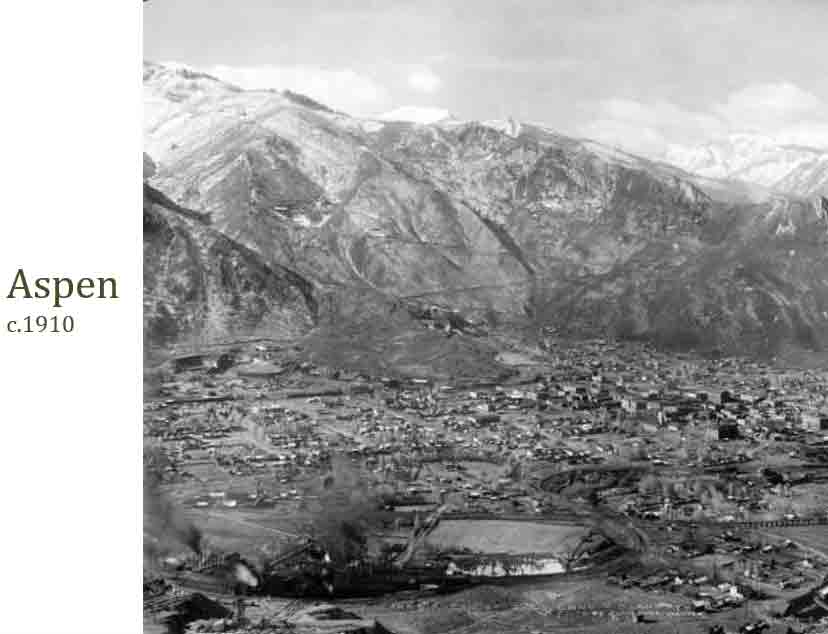
Lucien was only 22 in 1888 but he started to break out on his own. There is a letter from Will to their Father stating that Will wanted to put Lucien in charge of the Bay State Mine in Aspen. He thought Lucien could do it, but another owner didn’t want Lucien, because he had heard about Lucien’s wild ways. I don’t have much information on his wild ways. Just references from Will to his father in other letters about getting Lucien out of some spot of trouble or another.
Also in 1888, Lucien and Annie, Will’s wife, entered into a lease on the Celeste Mine on Aspen Mtn. that was to end up in court less than a year later. It was a lease on a sub-lease of a lease and it has made my head hurt trying to keep track of who did or did not do what. It included Lucien writing to Denver newspapers demanding the impeachment of the Pitkin County judge who originally ruled against him because the judge was the cousin of one of the mine owners and had himself bid and lost on the lease. It has been very easy for me find newspaper articles that announce lawsuits but how they come out, especially after an appeal or two is harder to find. So I don’t know how this turned out.
Clara
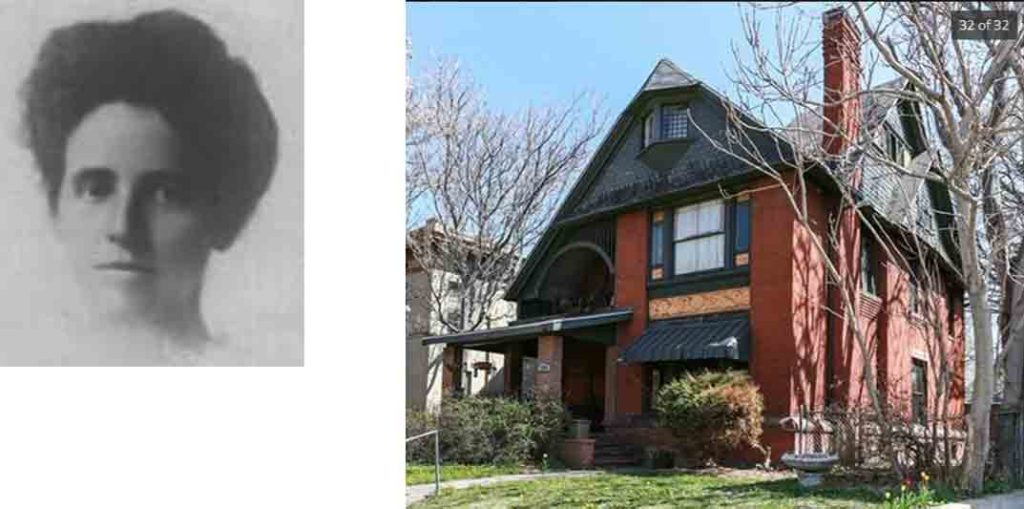
I haven’t said anything about Clara yet. In the eventful year of 1888, she married William H. Eddy. The announcement in the newspaper described him as a “successful Chicago merchant.” According the Chicago city directory, he was only a store clerk. But his Chicago connections were to play an important part 16 years later.
By 1889, Clara and William were living in this house at 1160 York along with her parents, Eliza and William. She raised five children, two nephews, and took care of her parents. The Denver city directories for the next twenty years show her brothers and various at this address but I am not sure that they actually lived there or just used it for mailing purposes.
In addition to William Eddy’s involvement in the family mining businesses, Clara also owned mining stock and property in her own name.
Around 88-89, there is a letter from Will to Lucien who is in Tin Cup, CO, telling him that if he finds the mine he has gone to look at is a good prospect, he should invest $30 each for their Mother, Eliza, and Clara.
The Patrick women all had property in their own names and according to correspondence between the brothers, Mother, Clara, and Annie all had opinions on one thing or another that the brothers were doing.
In 1889, Edward joined the family in Denver. I am sure that he had been giving legal advice from Chicago, but now he was closer to where his family needed him. He was admitted to the Colorado bar in 1890 and had an office downtown.
